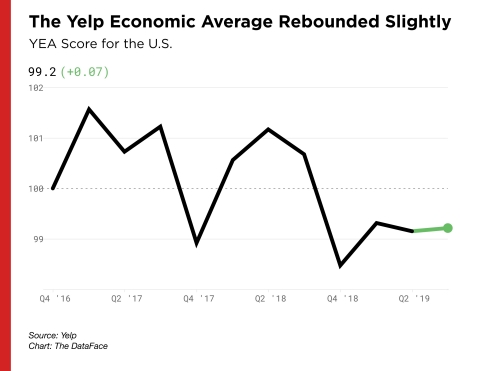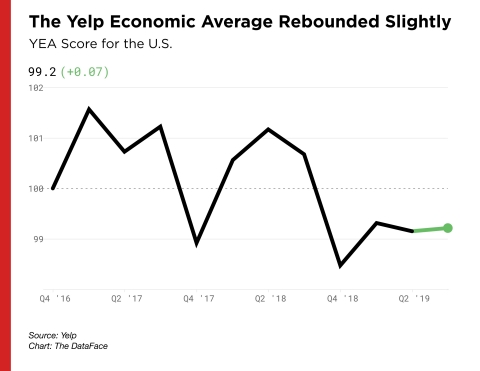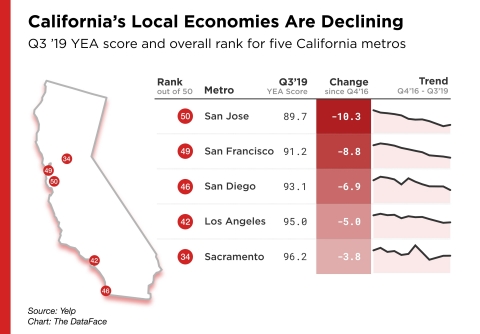SAN FRANCISCO--(BUSINESS WIRE)--Yelp Inc. (NYSE: YELP), the company that connects people with great local businesses, today released third quarter data for the Yelp Economic Average (YEA), a benchmark of local economic strength in the U.S. The report finds slow national growth, up by only .07% in the third quarter, as several of California’s local economies continued long-term declines, led by San Jose and San Francisco.
YEA is calculated from the fourth quarter of 2016, nationally and for 50 metros, reflecting data from millions of local businesses and tens of millions of users on Yelp’s platform. The report measures local economic strength through business survival and consumer interest. For every quarterly release since the introduction of YEA earlier this year, its change from the prior quarter has matched the change in GDP growth. According to researchers, Yelp provides a timely and accurate measure of a huge swath of the economy that is often missed by many major indicators.
“As China trade tensions, Fed deliberations, and impeachment inquiry talk trickles down to Main Street, the Yelp Economic Average has barely budged,” said Carl Bialik, Yelp’s data science editor. “At the same time, California’s biggest local economies are continuing to struggle. Construction limits and increasing rent are pushing consumers and workers farther from businesses, contributing to continued quarterly declines in some of the state’s biggest metro areas, with retail and restaurants taking the biggest hits.”
California’s Local Economy Declines
While reports show that California’s position in the national and global economies is strong, the state has seen the biggest decline in local economic activity among the 50 major U.S. metros YEA tracks. San Francisco, San Jose and San Diego all rank in the bottom five metros, while Los Angeles is in the bottom ten and Sacramento places below average. Limits to development around California have driven up housing costs, which has restricted the supply of workers, raised labor costs, and limited consumption, according to the McKinsey Global Institute.
California’s shopping businesses have been hardest hit, ranking at the bottom in each of the five California metros, with stores selling shoes, cellphones, and women’s clothing falling the sharpest. Restaurants, food, and nightlife categories are also struggling in all five California cities. The declines range from 2.6% in San Diego to 9.3% in San Jose, with an above-average fall of 6% in San Francisco. As rents in San Jose and San Francisco have surged, retail and restaurants have felt the impact.
San Francisco and San Jose have particularly struggled with construction limits and rents, and they’ve consistently ranked as the bottom two metros in the economic average in each of the last three quarters. The other California metros had been doing better at times but dipped in performance heading into this quarter.
New Fast Growing Cities Emerge
Buffalo (NY) and Pittsburgh (PA) join Milwaukee (WI), Honolulu (HI), and Portland (ME) in the top five boomtowns this quarter, knocking out Louisville (KY) and Memphis (TN) from last quarter. Home services businesses have been among the strongest in all five of the top metros. Local factors also propelled these boomtowns to their success, including food trucks in Milwaukee, life coaches in Buffalo, junk removal in Honolulu, juice bars in Portland, and software developers in Pittsburgh.
Shopping and Lower-Priced Restaurants Gain Ground
While still below its level three years ago, retail gained ground for a second straight quarter. Stores selling items that shoppers might want to check out in person were among the gainers: sporting goods, appliances, hardware stores, antiques, furniture stores, and art galleries. Department stores and women’s clothing also advanced. Cellphones and computers, which previously lost business to online retail, made a bit of a comeback this quarter.
Lower-priced and stay-at-home options were among the strongest in the restaurants, food, and nightlife categories, while several types of upscale restaurants declined, indicating a shift toward value and eating in. The strongest types of food and drink businesses in the third quarter included chicken wings, pizza, and sandwiches; and grocery stores, delis, and stores selling beer, wine and spirits.
For more assets and images, please find them here. For more information and Yelp’s latest metrics, visit: https://www.yelp.com/factsheet
Methodology
The Yelp Economic Average (YEA) is a composite measure of the economy, reflecting both business health and consumer demand among businesses in 30 sectors.
The 30 business sectors, or categories — the “Yelp 30″ — are drawn from eight umbrella business categories on Yelp: restaurants, food, nightlife, local services, automotive, professional services, home services, and shopping.
The share of YEA components from each of these eight categories is based on each one’s share of the economy, as estimated from County Business Patterns reports.
Each of the Yelp 30 is chosen based on maximizing four criteria, relative to other candidates within its family of categories, as measured in the first quarter of 2016:
- Number of businesses on Yelp in the category;
- Consumer interest on Yelp for businesses in the category;
- Number of the 50 metro areas — whose economic health we have been measuring a year and a half, originally as part of our Local Economic Outlook — in which the category is present;
- Uniform spread across the four Census Bureau-defined regions of the country.
We then chose baseline categories against which to compare the fortunes of the Yelp 30. This step helps remove changes due to seasonality and Yelp’s internal growth; what remains is a reflection of real economic patterns. We selected all other root categories not represented by the YEA components as baselines because they provided the most robust controls against seasonality and activity on Yelp.
For each of the Yelp 30 in each quarter, its two scores — one for business population and one for consumer interest — are calculated as follows:
- Count the component’s total for the quarter;
- For consumer interest only: Count the baseline’s total for the quarter;
- For consumer interest only: Divide the component’s total by the baseline total to get the component’s score;
- Divide the component’s score for the quarter of interest by the component’s score in the equivalent quarter in 2016 — comparing, for instance, the fourth quarter of 2018 to the fourth quarter of 2016, to adjust for seasonality;
- Multiply by 100 to make 100 a typical score.
Then the two scores are normalized to have the same variance, so that each contributes equally across components. To reduce the effect of outliers, the overall score for both consumer engagement and business count is the median of each component’s score. The YEA is the mean of the overall consumer engagement score and business-count score.
The YEA is separate from, and not meant to inform or predict, Yelp’s financial performance because our figures are adjusted to remove the effects of changes to usage of our product.
We calculated equivalent scores at the regional and metro level to provide a local look at the state of the local economy.
When comparing YEA to GDP growth we compare the change in both indicators rather than the absolute magnitude because they’re measured and reported differently.
About Yelp Inc.
Yelp Inc. (www.yelp.com) connects people with great local businesses. With unmatched local business information, photos and review content, Yelp provides a one-stop local platform for consumers to discover, connect and transact with local businesses of all sizes by making it easy to request a quote, join a waitlist, and make a reservation, appointment or purchase. Yelp was founded in San Francisco in July 2004. Since then, Yelp has taken root in major metros in more than 30 countries.



